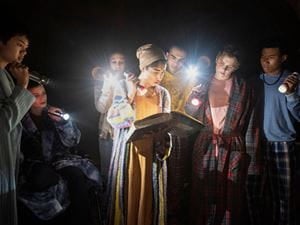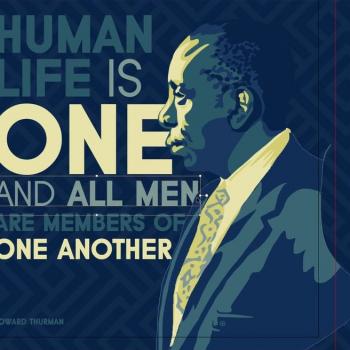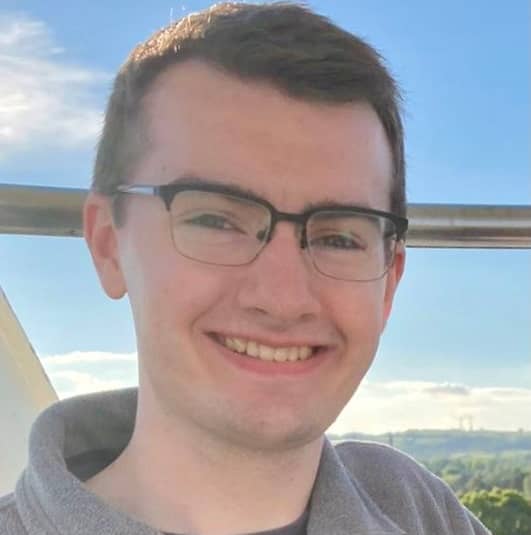
I’m no film expert, but if Mike Flanagan proved himself as a director with Midnight Mass (2021), still my favourite series a year on from its Netflix release, then The Midnight Club, out in time for my 23rd birthday – what a way to celebrate! – represents his triumph as a producer.
The show dished out spades of gallows humour, which was very much to my British taste. And, as with any Mike Flanagan shows I’ve watched, there wasn’t an episode without a powerful monologue, or several.
Sure, a few lines were mildly nauseating. Some sounded as if Karamo Brown from Queer Eye had written them – ‘However you feel is correct. However you’re feeling, whatever it is, is right’ – but it’s tough to think of anyone who does monologues better than Flanagan and his creative team.
The Midnight Club explores many themes: life after death; illusion versus reality; faith and its loss. In this article, I focus on Flanagan’s analysis of a concept I fear Christians often forget: solidarity. Thanks to Richard Rohr, Pope Francis, Walter Brueggemann and other thinkers, the word has made something of a comeback in the Christian lexicon. Even so, solidarity between all people has been overlooked as a subject in Western Christianity for too long.
Julian of Norwich, in the Revelations of Divine Love, was the theologian to write on human solidarity most eloquently: ‘For in the sight of God all men are one man, and one man is all men’ (LT, ch. 51). As His Holiness the Pope reminds his flock, ‘Solidarity acknowledges our interconnectedness’ (Let Us Dream, p. 53).
So, now that we have a feel for what solidarity means in Christian theology, let’s return to the show. The year is 1994. We meet Ilonka, the Californian high school student who will be the main protagonist. Ilonka reads the prologue to the main action, à la Chaucer’s Canterbury Tales.
From here, the first episode moves quickly. Five minutes in, Ilonka has collapsed on the bathroom floor. Down she goes after spewing blood and seeing a horrid apparition in the mirror. She receives a terminal cancer diagnosis and is taken into hospital, dashing her dreams of enrolment at Stanford University.
But Ilonka has not resigned herself to fate. She goes online in search of experimental cures. That’s when she chances on Dr Stanton’s Brightcliffe Hospice, ‘a place for terminal teenagers to transition on their own terms’ (Oddly glib alliteration). The centre gained renown after a girl called Julia Jayne, who wasn’t long for this earth when she went in, walked out a healthy seventeen-year-old.
But Ilonka soon learns, when she moves in, that all is not well in Brightcliffe. To start, she finds a pentagram under the bed in her dorm. Needless to say, she’s as horrified as if she’d spotted the Very Hungry Caterpillar in her chicken Caesar salad. This comes after having read that the hospice grounds hosted a shadowy cult in the 1940s.
I’m sure that little factoid won’t have implications later on…
For now, the time has come for Flanagan to introduce the titular Midnight Club. It’s made up of kids who live in the hospice, who sneak into the library when darkness falls to tell stories by the glowing fire. To begin every meeting, they drink to friends old and new: ‘To those before. To those after. To us now and to those beyond. Seen or unseen. Here but not here.’
Solidarity with all who have preceded us is likewise important in Anglican tradition. A Thanksgiving Service for the Faithful Departed is a chance to recall that we Christians, whether living or dead, ‘though many, are one body in Christ, and individually members one of another’ (Romans 12.5, RSV). A similar ethic underpins the Midnight Club. The whole thing, ‘To those before…’ feels highly liturgical in context.
What is this Midnight Club all about? Well, in another Chaucerian turn, we realise that Ilonka’s battle with cancer inside Brightcliffe is, in fact, a frame story. Like Chaucer’s pilgrimage down the Old Kent Road, it’s an overarching narrative into which other fables are embedded. Rather than everyday sinners and saints trading yarns in a medieval tavern for a free dinner, the Midnight Club is a forum for Brightcliffe’s residents to spin spooky fables.
These tales are the crucial mechanism for character development in the show. To various degrees, all are allegorical. While the frame story, set in Brightcliffe, presents the central conflict which all the characters go through together, in solidarity with one another, their narrative inventions in the Midnight Club are parables which uncover their lonely personal trials.
As in The Canterbury Tales, then, the tellers draw from their own experiences to spin out a fictionalised autobiography. With a medium size of a cast, and with a character-driven feel now the standard expectation of every Flanagan show, viewers will welcome the decision to structure the plot in a way that offers everyone a turn in the limelight. It allows audiences to get acquainted with, and invested in, all the characters.
But it’s not only the recurrent switching from the show’s frame story to the fables told in the Midnight Club which creates ambiguity between what is real and what is imagined. Other factors blur the tenuous line – assuming, always, there to be such an easy division – between the two realms…
The characters all suffer ghostly hallucinations but aren’t sure whether to blame these visions on paranormal agency rather than simply their medications. Although not certain how to describe their struggles, the Brightcliffe teens nevertheless manage to stand shoulder to shoulder in solidarity. This notwithstanding some obligatory moments of interpersonal tension!
‘With the meds that we’re on, I mean, they make us see stuff,’ says Kevin, a boy battling leukaemia. ‘I mean, it’s not just you,’ he reassures Ilonka, ‘It happens to all of us.’ Maybe that’s the key to the solidarity these two characters, in particular, develop. At root, it’s the same problem which afflicts them both, even while the repercussions differ.
A light-fingered Ilonka manages to steal a patient file on Julia Jayne, the girl who miraculously recovered even though diagnosed with inoperable cancer. She finds creepy charcoal sketches in this file, which look like they were drawn by Will from Stranger Things. Hidden in these artworks are the numbers 292.13.
Julia Jayne, it also transpires, founded the Midnight Club. Her name just keeps on cropping up. Ominously, the membership roll for the group, in which Julia Jayne’s is the first name recorded, is covered in bloody handprints. Undeterred, Ilonka pursues the 292.13 clue to find another book in the library. (292.13 is a Dewey decimal number.)
While Ilonka chases the secret behind Julia Jayne’s recovery, conflict unfolds between a gay guy with AIDS named Spence and a Catholic girl called Sandra. Here we detour into the theological again! ‘Your God said I’m an abomination,’ Spence angrily charges her.
To bury the hatchet, Sandra tells a tale with a homosexual protagonist, who gets cruelly bullied. Sandra finishes on a queer-affirming postscript: ‘God would never treat you like that,’ she stresses, referring to the bullies in the story.
With Spence and Sandra reconciled, Ilonka dives into the 292.13 book, which is a sinister diary written by Tom Riddle… no, hold on… a former Brightcliffe resident, Athena. The journal gives Harry… whoops… Ilonka, rather, an insight into the Hospice’s past. It was once home to the Paragon, a sect who practised occult rituals to prolong their lifespans.
Later, when Ilonka’s roommate Anya breaks down in her arms and confesses her fear of death, we witness Ilonka’s gaze trained on the gruesome diary. No prizes for guessing what’s going through her mind.
The lengths to which people will go to save the ones they care about, and whether this most Christlike of ends justifies even questionable means, is a typical Mike Flanagan theme and a fascinating moral question. (See also: Midnight Mass!)
‘If there’s a way to save her, to save me, to save us,’ Ilonka vows, ‘I’d burn the world down.’ She clearly has an ardent sense of solidarity with all who suffer. But Flanagan is always asking – like Stephen King does in Pet Sematary, so chillingly – whether sometimes, for the sake of our humanity, the wiser course is to welcome fate with equanimity rather than dare play God.
Alarm bells ring for Sandra, the Catholic, when the teens debate whether to try the ritual that Ilonka found in the diary. Sandra makes herself clear, ‘You don’t fuck around with this stuff. You don’t.’ Never mind our mortal frames, ‘It’s about saving souls.’ Do we purchase today at eternal cost? ‘For what does it profit a man to gain the whole world and forfeit his soul?’ (Mark 8.36, ESV).
Predictably, the kids do the ritual anyway. Howbeit, it utterly fails and wheelchair-bound Anya, who was knocking at death’s door, passes on. Ilonka feels gutted, ‘We were wasting time trying to change something that couldn’t be changed. We were wasting Anya’s time.’
But Ilonka meets a woman in the forest which encircles Brightcliffe, who seems to know something she doesn’t. It’s obvious this woman, Shasta, remembers the dubious denizens who formerly resided in the now hospice. ‘Life can prevail,’ she coaxes Ilonka, ‘That is what the Paragon was trying to do. They just got lost along the way.’ Well, the diary covered in blood would say that’s quite an understatement!
These interactions with Shasta, whom Ilonka runs into several times, lead her to conclude that supernatural goings-on are indeed afoot. In a passage of dialogue which inverts Kevin’s previous remarks, Ilonka holds forth on the visions the Brightcliffites have been having: ‘Our meds don’t make me see people in the hallways, in the room, in the goddam mirror.’
What accounts for these deliria, then?
The visions never do get a full explanation. What we do sense is an evil presence connected with all the dark witchcraft in Brightcliffe’s murky past. We get a vivid window to this world when Shasta, revealed as Julia Jayne, turns up to the Hospice with an entourage and Ilonka just allows them in, as you totally would. Shasta poisons her followers, hoping their vital essence will transfer to her, I suppose. But Stanton interrupts the rite and Shasta flees like a spanked rat.
We never actually find out what happens to Shasta / Julia Jayne, whose fate is left as a narrative loose thread. I’m unsure whether to spin the lack of resolution to her storyline, among others, as a creative choice to mirror the great unknowns of life or whatever. It sure makes for an anti-climax. Overall, though, Flanagan’s character work is good enough to counterbalance flaws in the plot.
Appropriately, the final tale to regale the Midnight Club is not an individual venture but a team effort. Every member chimes in. As a collective, the Brightcliffe Hospice crew guide one last story to completion. It stars a young woman, Imani, who likewise must face a premature death.
In the tale’s peroration, Imani has relinquished her grasp on this life and slipped away to the next world. ‘And there were many faces there Imani didn’t know,’ narrates Ilonka, ‘But somehow, her heart knew them all.’ Again, here we see the mysterious bond of solidarity which unites all people.
Far from being a pseudo-spiritual cliché from a Netflix ten-part show, human solidarity forms the central pillar of any Christian anthropology. ‘Through him all things were made,’ the Nicene Creed says of Jesus Christ.
Not one person is disposable, contra certain misguided theologies. ‘God created mankind in his own image’ (Genesis 1.27, NIV), words we’ve all heard a hundred times.
God freely created all that is, bestowing his own sacredness upon everyone, from womb to tomb (and beyond). Hence, as quantum physics has only proven yet more conclusively – whoever said science contradicted religion? – our lives are all entangled at every level. A thoughtful voyage into this theme, The Midnight Club earns my full-throated recommendation!
11/17/2022 10:39:52 PM





